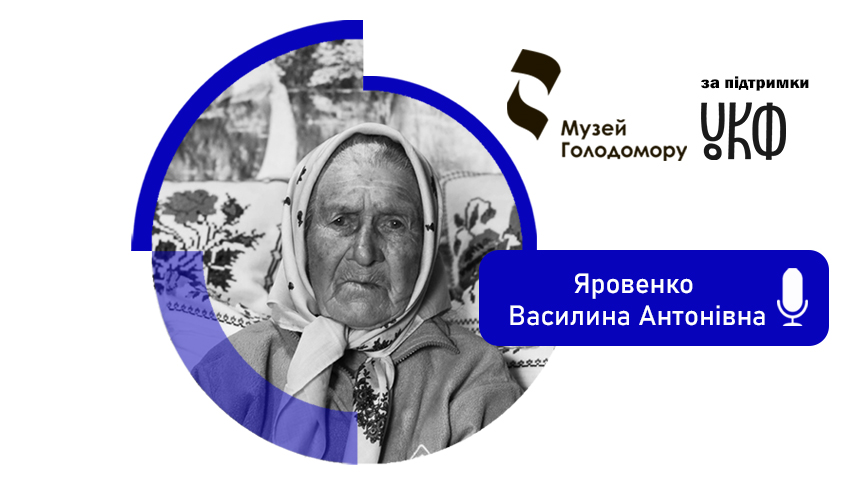Weeding beets for half a pound of bread: how Vasylyna Yarovenko survived the Holodomor without parents
We continue the series of publications about witnesses who survived the Holodomor genocide. The next woman found during the expeditions of the Holodomor Museum is Vinnytsia resident Vasylyna Yarovenko. She was born into a wealthy farmer family, but in 1932-1933 she had to grow up very quickly: a ten-year-old girl stayed without parents who left Ukraine due to repression and had to work on an equal footing with adults.
Wealthy farmers who sued the land from their master
Vasylyna Antonivna Yarovenko, before marriage- Kashchuk, was born on April 5, 1923. “On Thursday,” she adds, laughing as she talks about herself, and her daughter explains, “It was Maundy Thursday.”
Mr. Jablonski brought Mrs. Vasylyna’s mother, Teklia Frantsivna, from a Polish family of treasure farmers to the village Kuryantsi in the present-day Vinnytsia region. Franko Trotsky, Vasylyna’s grandfather, was the initiator of a collective lawsuit, and as a result, the farmers sued Jablonski’s land.Thus, the Trotsky family received a plot of land and started their farm. Instead, Mr. Jablonski later drank and finally became impoverished. People said about him: “In our village, such a master borrowed money from my grandmother.”
The father of our heroine, Anton, was the son of a wealthy farmer Ladymyr Kashchuk, who after 1917 divided his property between seven children. Anton inherited 5 hectares of fields, and by the standards of the mid-1920s, he was a middle-class man. The family took care of horses, sheep, pigs, and cows, and Kashchuk’s eldest son even kept a dovecote.
The house and farm were damaged by fire at the end of 1926, and the Kashchuks had to start over. They rebuilt the house and the barn, covered them with tin, gradually restored other rooms, and acquired an apiary. The father even started building a second house for his eldest son.
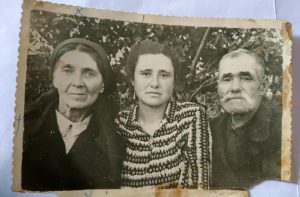
Vasylyna Yarovenko’s family. From left to right: Teklia Kashchuk (mother), Mariia Kashchuk (sister), Anton Kashchuk (father). 1940s
However, the happy life did not last long: the communist totalitarian regime planned to destroy Ukrainians, whom it saw as a threat to its existence.
Those who did not know how to manage were the first to go to the collective farm
When the residents of Kuryantsi village began to agitate to join the collective farms, those who did not know how to manage first agreed to this offer. Many people envied the more successful and wealthy owners, including Ms. Vasylyna’s father. In the village, they even said: “Kashchuk eats dumplings, and I will eat dumplings,” not realizing that behind these “Kashchuk dumplings” is hard daily work.
“The poor themselves were in the government, those who were in need, those who did not want to live. I know people who had a family and, as they said, a collective farm and a commune. Uh-huh! Commune! It will be a commune! And he does not understand! And he has three or five hungry children sitting there, and the field is empty for him,” the woman said. (The original language of the witness is still kept here.)
Yet communist propaganda in the village was often unsuccessful because of the remoteness of the people who carried it out from real life and the real needs of the people.
Vasylyna Yarovenko retells a comic situation that happened to one of the “activists” later, after the Holodomor:
“She went to the women for gardening beets. And why did she go? Did she see them? Does she know how to weed them? Well, she went to tell them something. She is literate, and there are women, they do not know the letters. “Why did you come to us?” Well, they pulled her away, and she began to run away and did not know how to escape. And she never came again. She also wanted to teach women something there… ”
Vasylyna’s father, Anton Kashchuk, as one of the most successful owners, was initially enrolled in the collective farm assets, but he did not agree to become a member, and he did not want to force fellow villagers to give property to the collective farm. He had to become a member of the collective farm and work there himself, delivering goods to the local store.
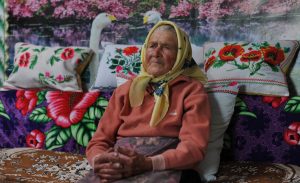
Vasylyna Yarovenko. Photo: Holodomor Museum
“Our priest was kicked out of the house”
Vasylyna’s grandfather, Ladymyr Kashchuk, first taught at a church-parish school, and in the late 1920s, he became a church elder. He was a friend of the local priest Yevhen Matsievych. When the Bolshevik attack on the church intensified, the priest, anticipating bad things, asked Ladymyr Kashchuk to buy all the furniture from his house and use the money to buy him a small one “so that he could live to his death.” That is how Vasylyna Yarovenko’s father furnished his home with the priest’s things:
“My father bought a mirror – from the ceiling to the floor, a clock like this, such a pendulum, so it hisses, two wardrobes – one for clothes, and one, with books there, plates and a table, such a round table on three legs, such large legs. Chest of drawers with three ones, a sofa similar to it, a couch, now they say a couch, and then they called it a sofa. Such a carpeted upholstery. In general, the situation was very good. “
As there was a lack of supply of literate people at that time, Priest Matsievich was offered to resign and work as an accountant on the collective farm. However, the priest refused to accept the following suggestion:
“I will not give up the cross, and I will not work as an accountant in the village.” “Somewhere, I might do it, but here, the kids will laugh at me,” Vasylyna Yarovenko retells his words.
The priest’s property was confiscated soon, and he was forced to leave his own home. The accommodation was turned into a school, and a small house, purchased for him by Ladymyr Kashchuk, was used for fuel. Priest Yevhen Matsievich died very soon.
Even very poor farmers were dekulakized and deported
In the late 1920s, dekulakization began – the extermination of a layer of peasant owners, or, as Vasylyna Yarovenko puts it, “owners.” However, the kulaks could be called not only wealthy farmers – anyone could fall into the crucible of repression. In the late 1920s and early 1930s, more than a million Ukrainians were deported from Ukraine to remote regions of the USSR, using the term “special immigrant.”
Life in special settlements for the “kulaks” was a real hardship that not everyone could stand. Some people died on the way to the North right in the “calf” cars.
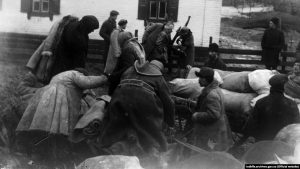
Dekulakization of the farmer P. Masiuk, v.Udachne, Donetsk region. 1934 CSFFSA of Ukraine named after GS Pshenichny
Several people were deported from Kuryantsi during the dekulakization. Muzychuk Hryhir, an elderly, owned a steam threshing machine that he rented out to other villagers. He was sent north with his wife Hivrona and their children. The man died on their way to the exile location. The wife decided to walk back home. She traveled from the Siberian taiga to Ukraine with a small child in her arms, squeezing dew from plants and asking for food along the way. Hivrona, on the other hand, couldn’t go to her house in her native village because a club had been organized there, and she was forced to settle in an empty house nearby.
The other “kulak” had no wealth at all. He and his two daughters were also deported from the village. His third daughter was able to hide instead, and since she was already married to our heroine’s brother Prokop, she moved to Kashchuk.
Vasylyna’s parents fled the village due to the threat of repression, and the girl had to survive on her own
After the dekulakization campaign, the communist totalitarian regime did not ease the pressure on Ukrainians. On the contrary, they went on the offensive, organizing the seizure of food, which led to the mass death of Ukrainians from starvation.
In 1932, the Kashchuk family, five members of which worked on the collective farm, received grain for their working days from a rich harvest:
“They earned so much bread – a full pantry. It was in the 32nd year that gave a rich harvest of bread.” Vasylyna Yarovenko recalls.
However, in the winter of the same year, just before Christmas, activists came to the house where the family lived to take their bread and arrest Prokop Kashchuk, Vasylyna’s brother. He was accused of stealing bread from a collective farm barn, “remembering” the “kulak daughter” he was married to, and sentenced to three years in prison with confiscation of property.
“Two carriages arrived, and people, this asset… Full in the halls, in the barn, are taken… Such bins, straw wickers were for bread. They took away all bread. They took away everything. Nothing left in the house. Radish was taken away from the couch, there was no place for the radish to be covered. Everything was taken away – at least from the canvas to sew something woven, home-woven, there was nothing,” the nine-year-old girl remembered those events.
So everything was taken away from the Kashchuks – not only food, but also furniture bought from the priest, benches, pillows, clothes, etc. These items were later sold at special fairs, but the activists took the best – a full-length mirror, which the residents of Kuryantsy saw in the priest’s house, was in one of the offices “in the area”. When they began to build a collective farm barn, they even removed the tin from the house, which covered the roof, and dismantled the Kashchuks’ barn.
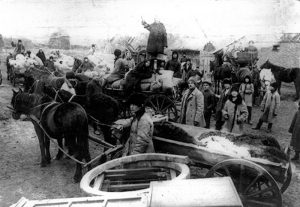
Sale of property of the dekulakizated farmer Martynenko at the “red bazaar”, v. Udachne, Donetsk region, 1930–1932, CSFFSA of Ukraine named after GS Pshenichny
When activists searched the house, Vasilina’s father, Anton Kashchuk, realized that he could be arrested, so he decided to flee. He took a loaf of bread under his armpit and asked his daughter to open the window in the next room unnoticed: “I’ll go out the window, and you don’t tell anyone, because if you tell anyone, I’ll be taken away and sentenced and maybe shot.”Although the girl was frightened, she silently complied with her father’s request. No one in the family knew where he was hiding.
As it turned out, the father reached Russia, to the Rybinsk city, located north of Moscow on the Volga River. He managed to find a job there, and he soon decided to take his family there. However, this should have been done in secret so as not to endanger the arrest.
Anton Kashchuk contacted his nephew and asked him to bring his family to Rybinsk. He took the mother and two younger daughters, but the eldest, Vasylyna, was asked by her mother to stay in Kuryantsi so that there would be someone to take care of her son and daughter-in-law’s children. So one day, the girl woke up in the house alone – her mother and sisters were gone.
In Rybinsk, as Ms. Vasylyna’s father recalled, there was no famine at all. My father worked as a handyman at a glass factory, and my mother was a cleaner. Later, when the famine in Ukraine subsided, the family returned home to Kuryantsi.
At this time, 10-year-old Vasilina Yarovenko was looking for different ways to survive. In particular, in the spring she went to work on a collective farm to weed beets. Despite the fact, she worked with adult women, and she got only half of what she earned – half a pound of bread, ie 200 grams.
“They go to weed beets, and they are in two rows. And one row was called a half-line. So who goes two lines – they give a pound of bread. A pound of bread is 400 grams. And who did one row, they give half a pound. Then they give me half a pound of bread, and they give them a pound. ”
In addition, a collective meal was organized on the collective farm. However, Vasylyna Yarovenko recalls that she could not even approach the cauldrons where food was cooked: in despair, hungry people tried to grab at least some food, and their behavior was more like an animal than human:
“Some dumplings were cooked there or something else. I didn’t even go there because they would suffocate there. It boils, it rumbles like that, women smoke under those cauldrons, and they climb, people shout with those bowls. It is like, well, a herd of cattle. Someone cause them some trouble, they run away, shout like that, it was terrible! ” the woman tells.
“People fell on the road”: at least 209 people died by famine in the village
No one in Vasylyna Yarovenko’s family died of starvation. However, the woman has remembered for the rest of her life how her acquaintances died.
Her neighbor Oleksandra Hubar buried her three adult sons, Mykola, Petro, and Pavlo. She survived with her youngest son, Ivan, who was eight years old at the time. She asked her friend Yuhyna Wojciechowska to help bury her sons. Nobody made a coffin then, so the women put the children’s bodies on the ladder, wrapped them, dug holes themselves, and covered them.
When the death toll reached its peak, a carriage drove across the village to collect the bodies of the dead and take them to the graveyard, where a large pile had already been dug, where the corpses were stored. Later, an iron cross was erected on the site.
“We had such a street on the edge of the village, a big long street, and there were a lot of children there. And these children, like, well, die again and again, and die again,” says Vasylyna Yarovenko.
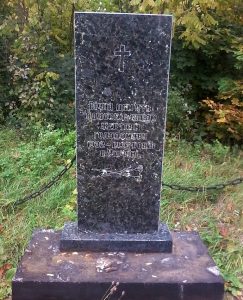
Monument at the site of the mass graves of the Holodomor victims in Kuryantsi village. Photo: Holodomor Museum
The woman remembers well the names of many fellow villagers killed by the famine of 1932-1933. According to eyewitnesses, the list of the Holodomor victims was compiled with 209 people by the village council. However, the real quantity can be much higher.
The fact that many orphans remained there after the Holodomor testifies to the mass deaths in Kuryantsi village. To take care of them, a patronage was organized at the collective farm, where children were brought up to adulthood.
At school, children had only breakfast of fodder beets
In 1933 Vasylyna Yarovenko already went to school. As “activists” even took clothes out of the house during the searches, she had nothing to wear in the winter. Vasylyna’s fellow villager bought her coat at the fair, paying 8 rubles, and offered her to work off this money – a month to graze his cow. The girl agreed, so she was able to continue her studies.
At school, Vasylyna and other students were not as “hungry” for knowledge as “hot breakfasts” of fodder beets:
“The fodder beets were washed, grated on a coarse grater and poured in water, and boiled like that. They cooked these noodles, which were such noodles. They salted and gave. At least you can take it hot, but there was nothing … “
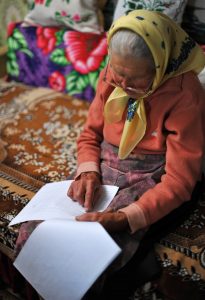
Vasylyna Yarovenko. Photo: Holodomor Museum
Acquaintances begged Vasylyna not to go to school in the winter because she could die of exhaustion or cold on the way. The girl realized that “hot breakfasts,” even if they were tasteless and not very nutritious, were her only salvation from starvation. But not all students were hungry – the activists’ children did not need “food” at school:
“And here were the hot breakfasts – it was obvious. Who eats it? If she ate something good at home, then why would she go there? And some were hungry. And there were those who were hungry. I always walked, ran away. At least something hot to eat. “
I grazed the cows and grazed myself
In addition to “noodles” from fodder beets at school, Vasylyna Yarovenko ate other surrogates – grazing a cow, she ate wild onions and garlic, as well as cumin. We also had to eat corn stalks, which had to be prepared to make them fit for consumption:
“I was cleaning corn, and there is such a cell inside. And I cut it in small pieces, put it and cook it. It does not boil. It is like rubber. And if it boils, you salt it, and you drink it anyway.”
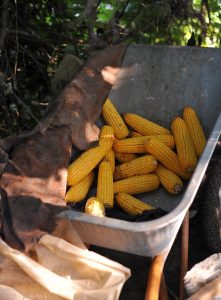
In Vasylyna Yarovenko’s yard. Photo: Holodomor Museum
Occasionally, Vasylyna also managed to fish with her cousin: his family fed the girl for help in fishing.
In order to survive, the girl also collected rye ears from a field left “under steam” (“steam” – a field that was sown not every year, but a year later to increase its fertility). It should have been done in secret so that “people would neither know nor see it.” The grain was rubbed in maсogon and donuts were baked from it.
Her neighbor Oleksandra Hubar also collected grain from the collective farm field for her youngest son, the only survivor of four children:
“Then she goes to the field and to work, she brings us some rye or wheat, some ears, she brings home in a handful or a pocket, because it was impossible to take it in a knot.”
The woman baked the grain in the oven and spilled it on the floor to occupy the hungry child. The boy escaped with these seeds.
***
Later, Vasylyna Yarovenko’s parents returned from Russia and started working in the Soviet farm of the nearby village, Novofastiv. They rebuilt their household gradually, which had been destroyed by the communist totalitarian regime.
Empty houses in the village Kuryantsi reminded the Holodomor for a long time. These events now live on in the memory of residents who tell family stories to their descendants.
The project “The Holodomor: a mosaic of history. Unknown Pages ” is implemented with the support of the Ukrainian Cultural Foundation.
